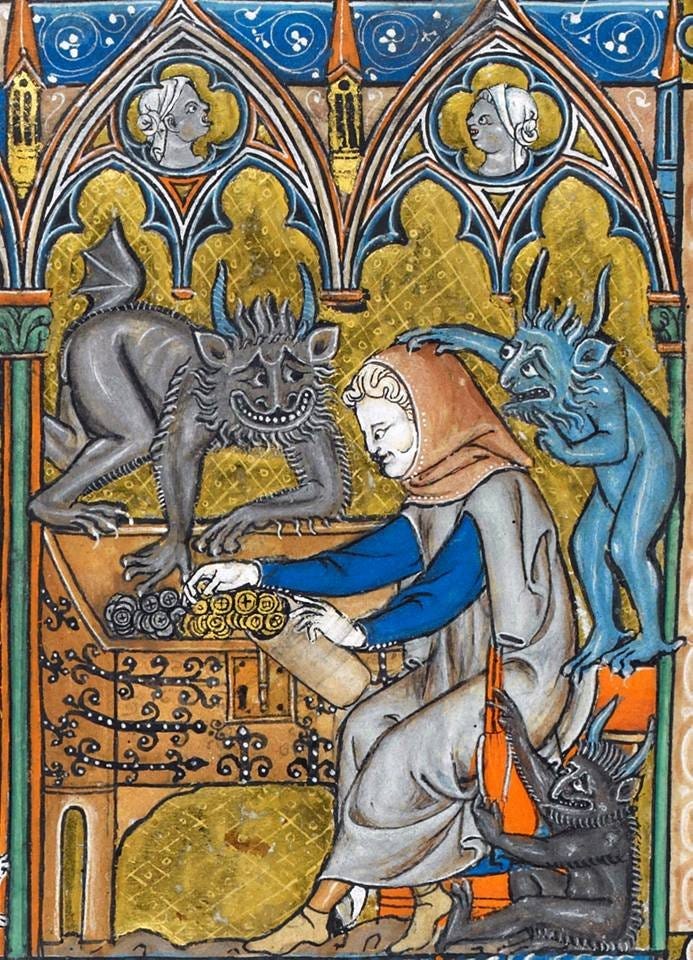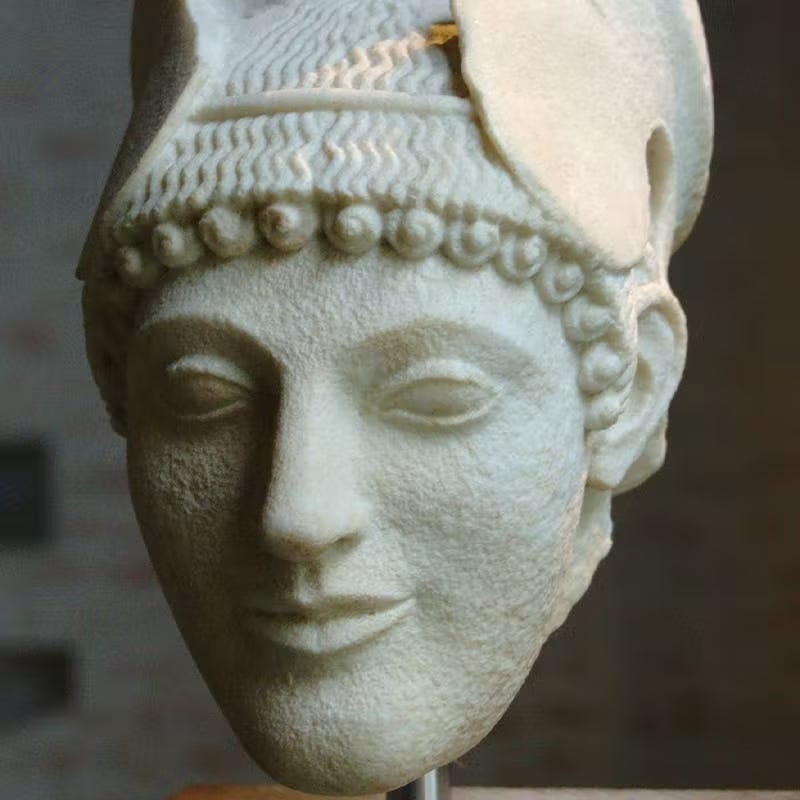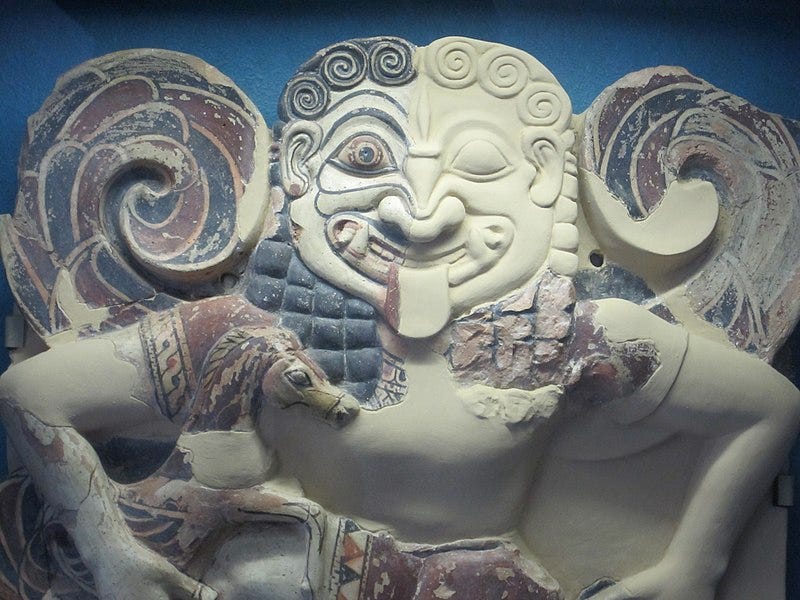The bare-tooth smile is an 18th century psyop. A collusion of theosophists and dentists. Prior to this time, a gaping smile was associated with the mad, the drunk or plebeians with no faculties of reason. All references to grins and open mouth laughter had negative connotations. On the battlefield of the Illiad, a broad grin accompanies celebration over fallen foes. Ares is ‘smiling with baleful looks’ as he charges into battle. The wide toothy grin of Medusa, which seems comical to modern eyes, was universally viewed by the ancients as a transfixing horror.
"The clothing of the body, and the laughing of the teeth, and the going of the man tell of him." —Ecclesiasticus 19:27
To smile broadly by curling back the lips and baring the teeth is the dominant expression of friendliness, happiness, and openness in the modern West. But this “natural” smile is an anomaly; it did not exist in human civilization before the 18th century. It is certainly not a positive gesture worldwide: in Japan, Iran, and Russia, smiling with visible teeth is broadly seen as a sign of foolishness and low cunning. It was little different in medieval Europe:
“Old English grennian and Middle English grennen indicate a display of teeth not usually in pleasure but in pain or anger (OED, s.v. ‘grin’). The Latin and Old French rictus similarly connoted oral fixity and strain, while Old and Middle High German grīnen indicates horror or anxiety, and, from the sixteenth century, grinsen signals a daft or mocking grin (DWDS, s.v. ‘grinsen’). When we consider medieval grins, we are often not engaging with smiles at all but instead with expressions of horror, rage, or despair, or, alternatively, stupidity, mockery, or inappropriate levity.”
—The grins of others: Figuring ethnic difference in medieval facial expressions Kim M. Phillips
In the medieval world, the toothsome grin was seen on the faces of demons, gargoyles, grotesques, green men, chimera and sheela-na-gigs. This use of the grin to represent the countenance of monsters is not limited to Europe, from the yokai of Japan, to the sanni masks of Sri Lanka, demons are almost universally depicted with a beaming smile. “A mouth which cracks wide open, exposing the teeth and lolling tongue, connects with the appetitive sphere of human behaviour, to the bestial and creaturely” (Binski, 1997, 354).
The smile serves many masters. Not all smiles are ‘small laughs’. Many are articulated when a child feels superior in mastery or exerts control. The very first endogenous or spontaneous smiles of infants happen during states of limbic excitation, in sleep or drowse, occurring as nervous energy falls and rises over a certain threshold. All over the world mothers plays peek-a-boo with babies, relying on interruption of stimulation to elicit a smile. Such smiles in the first weeks of life are responses to contrasts of stimulation—a constellation of face shapes hidden and revealed—not the content of stimulation. It is more or less a reflexive response to arousal. Even early elicited smiles in these first few months are more closely related to endogenous REM sleep smiles, than the intentional, social smiles of later infancy. The ontogenesis of the smile and laughter, at a base biological level, is the release of tension and the promotion of interaction.
Smiles and cognition are intertwined, mother responds to baby’s endogenous smiles and says, “Ah, he recognizes me.” (though he does not) and responds with greater affect. Thus, aliment is awarded to cognitive processes which lead to true recognition. Progressively, the proto-comic sense of contrasting bio-rhythms evolves into refined self-inspection. This awareness of contrasts triggers an initiation into the civilized condition; in a similar way, the smile later becomes the portal to further bonding and socially constructed consciousness, otherwise known as consensus trance. The human smile is the first channel by which the Collective patterns its thought-rituals onto the Individual. Indeed, there is evidence that laughter and the baring of teeth are rooted in an innate, ritualized threat response, which organizes hostile gestures toward an out-group. (Eibesfeldt 1970) (Lorenz 1963) (Ludovici 1932). Hostile laughter is at the root of social ordering systems.

The open-mouthed, maximal smile of the Westerner is like a silent laugh. Comedy has become ambient; a never-ending carnival. The most relevant function of the maximal smile and laughter comes to us from Bergson (1911), who reveals that laughter is a tool of social control and establishes taboos. “You would hardly appreciate the comic if you felt yourself isolated from others…. However spontaneous it seems, laughter always imposes a kind of secret freemasonry, or even complicity, with other laughers, real or imaginary”’ (Bergson 1913). Bergson argued that comedy is a game which mirrors human life and laughter is essentially aggressive, which finds accord with Thomas Hobbes (1651) who said, “Sudden Glory, is the passion which maketh those Grimaces called LAUGHTER; and is caused either by some sudden act of their own, that pleaseth them; or by the apprehension of some deformed thing in another, by comparison whereof they suddenly applaud themselves.”
In the Odyssey, the toothy grin of Odysseus recurs as a gesture of aggression and violence. His ‘sardonic smile’ is known to be a smile which bares the teeth without any signal of warmth or kindness. Odysseus smiles in anticipation of killing the suitors, clearly communicating bloodlust. Later, he smiles as their blood is purified from the palace. “Ulysses turned his head a little aside … smiling grimly in Sardinian fashion as he did so.” The word used is related to σαίρω, ‘grin or grimace’, often used in the teeth-baring expressions made by dogs and apes. Other smiles in comic or placid scenarios have separate formulas and are thought to resemble the closed lip ‘archaic smile’.

Kalypso resides in dangerous caves, an orally and vaginally dentated nightmare. Her lower grin gives birth to delusion and consumes resolve. Skylla leering with triple rows of teeth is seductress, inviting the adventurer into the dark deep. In the Liber Monstrorum, there are people with dentibus nitentem [shining teeth]. The hell-mouths, which could mirror masks of both tragedy and comedy, were a portal toward the Unconscious, to that irrational realm where the joke and the dream rhyme.
Keep reading with a 7-day free trial
Subscribe to Schwabstack to keep reading this post and get 7 days of free access to the full post archives.








